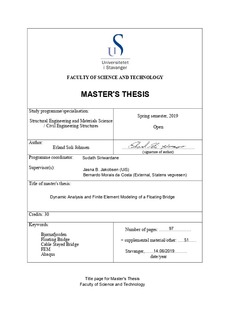| dc.contributor.advisor | Jakobsen, Jasna B. | |
| dc.contributor.advisor | Bernardo, Morais Da Costa | |
| dc.contributor.author | Johnsen, Erland Soli | |
| dc.date.accessioned | 2019-10-09T07:24:25Z | |
| dc.date.available | 2019-10-09T07:24:25Z | |
| dc.date.issued | 2019-06-14 | |
| dc.identifier.uri | http://hdl.handle.net/11250/2621056 | |
| dc.description | Master's thesis in Structural engineering | nb_NO |
| dc.description.abstract | With the aim of reducing the travel time of the coastal highway E39 by substituting ferries with bridges and tunnels, the National Public Road Administration project “Ferry Free E39” includes several fjord crossings demanding utilization of new technology and concepts. Crossing of the 4,5 km wide and up to 600 m depth Bjørnafjorden is designed with a floating bridge and cable stayed part, which is further studied in this thesis.
The long and slender structure with only fixed ends results in a structure with low stiffness suspect to both wind and wave loads, which in nature are dynamic. Assessing the dynamic properties and response is thus of high importance. Thesis emphasis is on the constructing of a finite element model which will be loaded with simplified buffeting wind loads.
Model geometry and properties are established in MATLAB, while the finite element code Abaqus is utilized for both basic eigenanalysis and the dynamic response analysis in the time-domain.
Due to the curvature of the bridge, a 4 dimensional wind simulation script provided by UiS postdoc Etienne Cheynet, which relaxes Taylor’s hypothesis of frozen turbulence is utilized. The model is based on a modified decay coherence function utilizing two decay coefficients. Turbulent wind representing 100 year return period conditions, lasting for 1 hour, are simulated and a total of 20 turbulent wind fields are utilized in a corresponding number of dynamic analysis.
Several simplifications are done on the modeling of the floating bridge. Only simple terms of the buffeting terms is applied, in which the aerodynamic coefficients are not utilized as dependent on the yaw angle. Hydrodynamic effect are extensively simplified, excitation forces, damping, restoring terms nor frequency dependent added mass are included. Only the effect of a constant added mass provided by low frequency waves. However the first 5 eigenmodes obtained with eigenmodes in between 120 s and 16,7 s are similar to prior results. Implying behavior of the obtained model is accurate when analyzing the response governed by the first eigenmodes.
Large deviations in the simulated bridge response are noted by applying wind from several different directions in the 1 hour analysis. Forces are observed to be greatest in wind with cardinal direction 280° and 100°, in which the wind from west provides a large moment about the strong axis of the bridge girder, the latter providing a great compressive axial force in the bridge girder.
To achieve a proper model, implementation of several additional terms in the turbulence wind load application provided by the buffeting theory presented by Davenport. Along with implementation of fundamental hydrodynamics; excitation forces, frequency dependent added mass, damping and restoring terms to further study the coupled effect of hydrodynamic and aerodynamic loads.
This thesis outlines a method in which the stiffness and mass matrices obtained through Abaqus is adequate comparing to prior consultants reports, utilizing the method described will efficiently found the foundation further implementation of aerodynamics and hydrodynamics discussed above. | nb_NO |
| dc.language.iso | eng | nb_NO |
| dc.publisher | University of Stavanger, Norway | nb_NO |
| dc.relation.ispartofseries | Masteroppgave/UIS-TN-IMBM/2019; | |
| dc.rights | Navngivelse 4.0 Internasjonal | * |
| dc.rights.uri | http://creativecommons.org/licenses/by/4.0/deed.no | * |
| dc.subject | Bjørnafjorden | nb_NO |
| dc.subject | FEM | nb_NO |
| dc.subject | Abaqus | nb_NO |
| dc.subject | ferjefri E39 | nb_NO |
| dc.subject | byggkonstruksjoner | nb_NO |
| dc.subject | floating bridge | nb_NO |
| dc.subject | cable stayed bridge | nb_NO |
| dc.subject | konstruksjonsteknikk | nb_NO |
| dc.title | Dynamic Analysis and Finite Element Modeling of a Floating Bridge | nb_NO |
| dc.type | Master thesis | nb_NO |
| dc.subject.nsi | VDP::Technology: 500::Building technology: 530::Construction technology: 533 | nb_NO |

